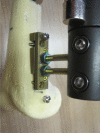Lengthening over nails using the double plate system ONAS-DPS
- PMID: 27163094
- PMCID: PMC4849230
- DOI: 10.1051/sicotj/2015040
Lengthening over nails using the double plate system ONAS-DPS
Abstract
Stable insertion of large Schanz screws behind an intramedullary (IM) nail when lengthening over nails (LON) may be difficult due to the limited bone stock. Additionally, the highly probable contact between the screws and IM nail (which is difficult to avoid) increases the likelihood of infection spreading from the skin via Schanz screws directly to the IM nail. A new device for LON has been developed. Instead of inserting Schanz screws from the external fixator beside the IM nail (as in standard LON), a system of two overlaying plates was constructed. Schanz screws can be fixed to the plates without entering the bone. The plates are fixed to the bone using four angle stability screws. The holes in the plates offer stabile fixation for a chosen angle under which the screw is positioned through the cortical bone. Using the new system there is no need to place Schanz screws behind the IM nail. Instead, Schanz screws pass to the plate and not through the bone. The new system for elongation over IM nail is called "Over Nail Angle Stability-Double Plate System" (ONAS-DPS) [Antolič V (2013) Modular side device with an intramedullary nail for guiding a bone during its lengthening. World Intellectual Property Organization. International Publication number: WO 2013/176632 A1].
Keywords: Angle stability plate; External fixation; Intramedullary nail; Lengthening over nail.
Figures






References
-
- Paley D (2005) Principles of deformity correction. Berlin, Heidelberg, New York, Springer-Verlag.
-
- Chanchit S (2008) Distraction osteogenesis of the femur using conventional monolateral fixator. Arch Orthop Trauma Surg 128(9), 889–899. - PubMed
-
- De Billy B, Langlais J, Pouliquen JC, Damsin JP (2005) British society for children’s orthopaedic surgery/GEOP combined meeting: complications in lengthening of the femur using different methods. J Bone Joint Surg Br 87-B (SUPP I), 70.
-
- Paley D, Herzenberg JE, Paremain G, Bhave A (1997) Femoral lengthening over an intramedullary nail – a matched-case comparison with Ilizarov femoral lengthening. J Bone Joint Surg 79-A (10), 1464–1480. - PubMed
LinkOut - more resources
Full Text Sources
Other Literature Sources
